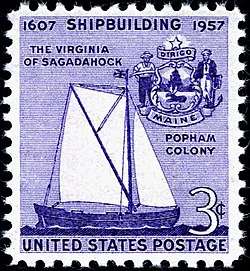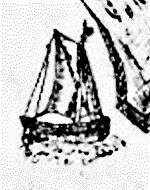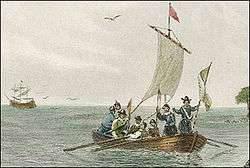Virginia (pinnace)
Virginia or Virginia of Sagadahoc was a pinnace built in 1607–08 by colonists at the Popham Colony. The ship was a project of the Plymouth Company, branch of the proprietary Virginia Company, on land England claimed as belonging to the Virginia Colony. She was the first English-built ship in what is now Maine and possibly in all of the English-colonized areas of North America, and a demonstration of the new colony's ability to build ships. The second and third "local" pinnaces (Deliverance and Patience) were built soon afterwards in Bermuda following the loss of Sea Venture during the Third Supply.
 Virginia, as commemorated on a 1957 U.S. Postage stamp | |
| History | |
|---|---|
| Name: | Virginia |
| Ordered: | Summer, 1607 |
| Builder: | Mr. Digby, James Davis |
| Laid down: | Autumn, 1607 |
| Launched: | Winter/Spring, 1608 |
| In service: | Spring 1608 |
| Out of service: | ?Fall, 1610 |
| Homeport: | Popham Colony, then Jamestown, Virginia Colony |
| Fate: | unknown |
| Status: | ?wreck |
| General characteristics Small Pinnace | |
| Type: | pinnace |
| Displacement: | 30 tons |
| Length: | 50 ft (15 m) |
| Beam: | 14.5 ft (4.4 m) |
| Draft: | 6.5 ft (2.0 m) |
| Propulsion: | At least three rigs possible: a) square-rigged main mast, gaff-rigged second mast, square sail under bowsprit, topsail; b) fore-and-aft rigged with sprit mainsail; and/or c) aft-rigged mizzen mast with lateen sail. |
| Speed: | ? 2-7 knots |
| Range: | offshore, ocean |
| Complement: | ?2 |
| Armament: | None |
| Armour: | None |
| Notes: | Virginia was the first English ship built in the Americas to cross the Atlantic. Virginia is a fine example of the 'small' pinnace design which could be fitted with a variety of rigs, and thereby had great flexibility as to designated tasks. |
Virginia was built at the mouth of the Kennebec River in what is now Phippsburg, Maine. Little is known about the details of her architecture, but written accounts of the colony and historical records of similar ships suggest that Virginia was a pinnace that displaced about 30 tons and measured somewhat less than 50 ft (15 m) long, with a beam of 14 ft 6 in (4.42 m). She had a flush main deck, drew about 6 ft 6 in (1.98 m) fully loaded, and had a freeboard of less than 2 ft (0.61 m).
Background
The Popham Colony, also known as the Sagadahoc Colony, was established in 1607 by the Plymouth Company. It was situated near the present town of Phippsburg, Maine near the mouth of the Sagadahoc River, now the Kennebec River. The expedition's mission was to find gold, the Northwest Passage, a river passage to China, to fish and hunt Beaver for fur and to sell and prove that New World forests could build English ships.
During the 12 months the colony existed, the colonists completed one major project: the construction of a 30-ton ship, a pinnace, they called Virginia. It was the first known ship to be built in what would later become the United States of America by Europeans, and the first ship of noteworthy size for which solid evidence exists that she was constructed there. It was also meant to show that the colony could be used for shipbuilding. The choice to build a 'small' pinnace for the Popham Colony was a good one. Able to support at least three different rigs, the 'small' pinnace was very versatile and could be assigned to offshore fishing, the North Atlantic fishing grounds, or readied for a trans-Atlantic journey to England with equal ease.[1]
At this time the term "pinnace" could mean either a larger full rigged pinnace, or a smaller ship that could be stowed (or towed) and used a ship's tender. Virginia was a pinnace of the smaller type, although perhaps similar to a shallop. Shallops are mentioned as often as the pinnace in earliest records of water craft in the European colonies in North America but is rarely described as a 'ship'. The largest shallops might approach the smallest 'small' pinnaces in size, but average size was much smaller and places the shallop within the category 'boat'.
Design
Virginia would have been about 56 feet long with a beam of 15 feet 5 inches, a flush main deck that drew approximately 6 feet 5 inches fully loaded, a freeboard of less than 2 feet, and weight of approximately 30 tons. Sketches of the replica's hull design and framing are online at the Maine First Ship website.[2] For ocean voyages, Virginia would likely have been rigged with a square-rigged main mast, a much smaller second mast that was gaff rigged, and a small square sail under the bowsprit. The main mast on many pinnaces would have been large enough to carry a small topsail. Plans for Virginia that include a plausible rigging are available from the Maine Maritime Museum.[3]
For coastal work, Virginia would have used a fore-and-aft rig with a sprit mainsail and one headsail.[4] How the coastal rigging would have been changed for a cross-Atlantic voyage is not yet fully understood. In John Walker's drawing of Virginia when rigged for a trans Atlantic voyage, an aft-rigged mizzen mast carries a sail that resembles a lateen sail more closely than a spanker. This variety of rigs enabled the 'small' pinnaces of this era for several different assignments. They could be used as fishing boats, storage at anchor, tender to large ships or supply ships that were often towed to their destination by a larger ship.

There is a very small 17th-century sketch of a pinnace on J. Hunt's October 8, 1607, map of Fort St. George at the Popham Colony in southern Maine - see image.[5] This boat is thought to be the 30-ton pinnace Virginia that was built in 1607–1608 at the Popham colony on the Sagadahoc River (now Kennebec River) in southern Maine. Assuredly, lofting was done by 'eye'. Assembly was done under the guidance of shipwright Mr. Digby; and James Davis (mariner), Master of the Gift of God.[6]
Voyages

The ship's first major role came on October 17, 1608, as the Popham Colony was abandoned when Captain James Davis and 45 colonists packed into Virginia to return to England.[7][8][9] Structurally sound after her first ocean crossing, Virginia had more work to do. On May 23, 1609, a new Charter of the Virginia Company, drafted by Francis Bacon, was signed by King James I of England. This Charter granted a vast extension of territory and expanded powers to the Company, spurring a renewed effort to save the remaining colony at Jamestown.
Virginia was one of two pinnaces and seven larger ships in the fleet known as the Third Supply. With 500-600 people, the supply mission left Falmouth, Cornwall, England on June 8, 1609, directly for the colony in Virginia by way of the Azores and Bermuda. Virginia and one other pinnace were towed by the 300 ton purpose-built flagship, Sea Venture, which was the first single-timbered merchantman built in England, and also the first dedicated emigration ship. The fleet encountered a powerful three-day hurricane near Bermuda[10] resulting in the loss of two ships, Catch and Sea Venture. Meanwhile, Davis guided Virginia safely to Jamestown, arriving on October 3, 1609. This arrival was six weeks later than the other ships that had not been 'captured' by the Bermuda hurricane of late July, 1609. The long travel time suggests that Virginia may once again have been in tow behind a larger ship, or significantly blown off course, or damaged.[11]
John Smith's refusal to resign the governorship had promoted political divisiveness, and the arrival of the battered fleet's limited supplies and extra mouths was not greeted with enthusiasm. Nonetheless, Davis became the Commander of the Fort Algernon at Point Comfort. Virginia become a safe refuge when Indian hostilities erupted. She was also used to go inland to relieve Fort Algernon and attempt trade with the Powhatan confederacy. During this trip, Davis decapitated two Indians and left their mutilated bodies near the fort. On yet another inland foray, he destroyed a Powhatan village, burnt their corn and killed all men, women and children. Davis was soon in command of three forts. Afterward, Virginia and Davis returned safely to England.
The last known details of Virginia were in 1610 when she once again delivered settlers and supplies to the Jamestown Colony under the command of Tomas West. After the return to Jamestown in mid-June, Captain Robert Tyndall was directed to take Virginia to catch fish in the Chesapeake Bay between Cape Henry and Cape Charles. There is no mention of Virginia afterward in known historical records.[12]
Replica
The pinnace Virginia is being reconstructed by an all volunteer group Maine' First Ship just upriver from the site it was originally built. The design was completed in 2007 after extensive research, hampered by the lack of historical information. The keel was laid on July 3, 2011. The reconstruction is being done in and around the Bath Freight Shed in Bath, Maine. Virginia is expected to be launched in 2021. The goal is to create a floating classroom for students of all ages, promote an appreciation of Maine's early shipbuilding heritage, the Popham Colony, and its relationship with the Wabanaki.
Footnotes
- “Building a Replica of the Virginia.” Retrieved December 8, 2010. Fred M. Walker and Associates of Tenterdon produced concept drawings, David B. Wyman, Naval Architect developed the working design with important input from Captain Steve Cobb, Shipwright Rob Stevens and Maine's First Ship Historian, John Bradford. Plans were finalized and the Maine's First Ship Project was formed at Bath, Maine in 2007.
- Virginia Drawing Slide Show, n.d. Retrieved December 7, 2010.
- Catalog of Plans of Historic Boats and Ships at the Maine Maritime Museum, Bath ME, 2008. Retrieved September 1, 2008.
- Sailing Ship Rigs, nd. Retrieved January 26, 2011
- Surviving Sketch of the Virginia at the Maine Penobscot Marine Museum, Searsport, Maine, 2006. Retrieved September 18, 2008. This map was found in an archive in Spain, deposited there by a well-intentioned spy at an unknown date. Retrieved December 18, 2010.
- History of Popham Colony. Retrieved December 19, 2010.
- According to Charles M. Andrews (The Colonial Period of American History, Yale University Press, 1934, I, 92) confirms the return of Virginia to England with Popham colonists, after which she would return to the service of the Virginia Company. John H. Morrison (History of the New York Ship Yards, New York, 1909) corroborates the above and indicates that colonists sailed in her to the colony at Jamestown in 1608.
- Captain James Davis, 1580-1623: The Early Settlement of New England & Virginia Archived 2008-09-06 at the Wayback Machine. retrieved September 2, 2008..
- History of Popham Colony, Retrieved December 18, 2010. Evidence of the Popham Colony remained buried until discovered by Dr. Jeffrey Bain in 1997.
- Wash & NoVa Company - Biographies - James Davis
- Captain James Davis, 1580-1623, The Early Settlement of New England & Virginia Archived 2008-09-06 at the Wayback Machine by Kerry S. Davis, 2009. Retrieved September 2, 2009.
- 1606/1607 Voyage To Virginia., Retrieved on Sept.22, 2008
External links
- Popham Colony
- Captain James Davis, 1580-1623: The Early Settlement of New England & Virginia
- The Sailing Ships of New England, 1607-1907, by John Robinson and George Francis Dow, Marine Research Society, Salem, Massachusetts: 1922.
- The 1606/1607 Voyage To Virginia.
- Surviving Sketch of Virginia
- Building a Replica of Virginia
- The Pinnace Virginia Building project video
- Sailing Ship Rigs
- Maine's First Ship A project to reconstruct Virginia
- How the Virginia was Built, A speculative reconstruction.
- English Expeditions to Powhatan Country
- The 1606/1607 Voyage To Virginia
Further reading
- History of the Popham Colony 1.
- History of Popham Colony 2.
- Maine's Popham Colony by William H. Tabor, Athena Review 3(2).
- Pinnace Virginia at Maine Penobscot Marine Museum.
- Pinnace Virginia model on display.
- Learn More about Virginia (pinnace).
- Catalog of Plans of historic boats and ships.
- The Ship's pinnace in Cook's Bay (ie HMS Endeavor, replica)
References
- Mathew Baker and the Art of the Shipwright (in German). Baker was royal ship builder under Elizabeth I. His Fragments of Ancient Shipbuilding (1586) is considered a ground breaking work and invaluable for the study of 16th century shipbuilding. Sept.15, 2005. Chapter 3 (pp. 107–165) of Stephen Johnston, ‘Making mathematical practice: gentlemen, practitioners and artisans in Elizabethan England’ (Ph.D. Cambridge, 1994).
- Some Seventeenth-Century Vessels and the Sparrow-Hawk, by William Avery Baker. Pilgrim Society Note, Series One, Number 28, 1980, April 30, 2006 (Plymouth Hall Museum, Plymouth Massachusetts. Historical notes about pinnaces and shallops used during the early years of the Plymouth Colony).
- Ashmore Family from Eng to Va, Md, Ga & Ar Genealogy, tales about early colonists in the mid-Atlantic Colonies and sea battles between the adventurers of Maryland and Virginia Colony. Four pinnaces are mentioned by name.
- 'Relation' concerning Captain James Davis (1580–1623) and the early settlement of New England & Virginia.